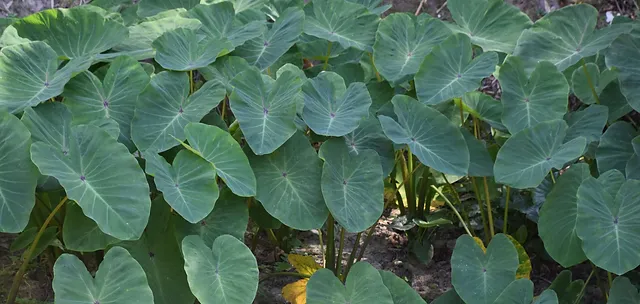The plant has been attacked by a pathogen which leads to defoliation, reduced yields and a significant deterioration in production quality
Taro, whose scientific name is « Colocasia esculenta » and is commonly known as « mazonbèl » in Haiti, has been facing an epidemic affecting several of the country’s provinces since the 2000s. The plant is being attacked by Phytophthora colocasiae, a pathogenic agent causing defoliation, reduced yields and a significant deterioration in production quality. This fungal disease can cause severe damage to « mazonbèl » crops, causing brown and necrotic lesions on the leaves.

The plant « mazonbèl, » scientifically known as « Colocasia esculenta ».
Without intervention from the authorities, « mazonbèl » cultivation is in free fall. This high-energy food, rich in starch, proteins, lipids and numerous vitamins, was highly prized in various regions of the country. Its leaves, stem and roots are all used in the Haitian diet.

The plant «mazonbèl»
Rodlin André, a farmer in the 2nd section of Les Perches in the northeast, has been growing taro for almost ten years. He says he is « concerned » by the decline in his income.
According to agronomist Emmanuel Jean-Louis, the epidemic spreads via several vectors – citing the country’s import-export routes, the migration of insects from one region to another, and cyclonic waters.
However, to date, no research into the exact origin of the epidemic has been carried out in Haiti.
Also see : The local variety of coffee disappearing in Haiti
« We’d like to grow mazonbèl on a large scale, because it’s a product that generates a lot of money, » says Jean Ritho Désiré, an agricultural technician in the 8th section of Petit-Goâve. Since the loss of a large portion of his harvest between 2007 and 2008, Désiré has been growing a very small quantity of seedlings.
No research into the exact origin of the epidemic has yet been carried out in Haiti.
According to the 2010-2025 agricultural development policy published by the Ministry of Agriculture, Natural Resources and Rural Development (MARNDR), the local production of tubers in Haiti is substantial. The United Nations Food and Agriculture Organization (FAO) estimates it at around 750,000 metric tons – mainly bitter varieties used to make flatbreads – 45% of which is manioc.
Mazonbèl, a great variety among tubers, is generally grown on dikes or mounds in wet, muddy and marshy areas. It differs from « Tayo », also known as « Malanga », which is grown on dry land.

The plant «mazonbèl»
Growth in Haiti’s agricultural sector remains weak and varied. In a special report published by the FAO and the World Food Programme (WFP) in September 2010, the tubers grown in Haiti mainly include yams and taro (both tayo malanga and taro mazonbèl), planted specifically in the agroforestry systems of Grand’Anse, Nippes du Nord and part of Nord Ouest.
Growth in Haiti’s agricultural sector remains weak and inconsistent.
Managing the disease attacking mazonbèls must involve a combination of cultural practices, according to specialists. In addition to crop rotation and sanitation, growers should also consider the use of pesticides, says agronomist Clerveus Jean-Fritzner, head of MARNDR’s plant protection department.
Lire aussi : L’oiseau Kanson Wouj, emblème national d’Haïti, menacé de disparition
It should be noted that, to date, Haiti has no real infrastructure for pesticide production.
MARNDR’s Projet Territoires Productifs Résilients (PTPR) drew up a pesticide management plan in November 2017, in which it recommended several cultural methods to control the fungus. First, it is incumbent to carry out a sanitary vacuum consisting of removing all plants from the plot at the first stage of development of the disease. These plants must be burnt or buried deeply. The plot should then be left fallow for two years before planting other crops.

The plant «mazonbèl»
Then there’s chemical control and the use of tayo varieties resistant to the disease.
For existing crops, agronomist Emmanuel Jean Louis recommends a simple treatment of cuttings with water and chlorine, i.e. 0.7 liters of chlorinated water per ten liters of water. The cuttings should then be air-dried before planting.
Local tuber production is substantial in Haiti.
For the few mazonbèl crops that have not been infected, agronomist Clerveus Jean-Fritzner recommends preventive measures, such as: using certified seeds free of infectious germs, disinfecting cultivation tools and equipment, and avoiding intensive « mazonbèl » cultivation.
Lire aussi : Èske ou renmen manje fwi ki rele Djaka a ?
Several solutions have also been proposed by the MARDR to revitalize mazonbèl cultivation in Haiti. According to agronomist Jean-Fritzner, these include testing and research to assess the situation, as well as importing other mazonbèl varieties, mainly from the Pacific islands.
Agronomist Rock Lindor contributed to this report.
English translation by Sarah Jean.
© Cover image : freepik
Watch our special report filmed in March 2021 with wildlife photographer René Durocher in action in Haiti:
Stay in touch with AyiboPost through :
► Our Telegram canal : click here
► Our WhatsApp Community : click here







Comments